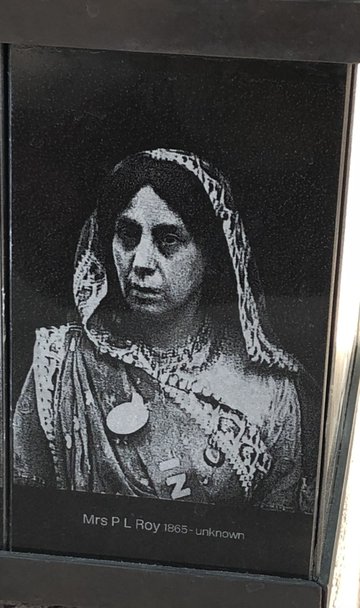
Lolita Roy
Indian suffrage campaigner who lived with her six children in London in the early twentieth century
Other names
Mrs P. L. Roy
Place of birth
Date of arrival to Britain
Location(s)
Carlton Gardens
Ealing
London
United Kingdom Brook Green
Brook Green
Hammersmith
London
United Kingdom
Place of death
Unknown
Date of time spent in Britain
c.1900–20
About
Lolita Roy was notable for her involvement in the British suffrage movement and in fostering Indian connections in London in the early twentieth century. Born in 1865 in Calcutta, India, she married Piera Lal Roy, a barrister and director of public prosecutions in Calcutta, in about 1886. They had six children (three girls and three boys), all born in Calcutta between 1889 and 1900: Leilavati, Miravati, Paresh Lal, Hiravati, Indra Lal and Lolit Kumar.
By 1900 Roy and her six children had moved to west London. Her husband remained in India and the household in London had a housemaid and other domestic servants. All six children were educated at St Paul’s Girls’ School and St Paul’s School.
Roy was involved in several social organizations for Indians in London. She was a committee member of the National Indian Association. From 1908 Roy was President of the London Indian Union, a society that organized meetings for Indian students in London. She was a founding member of the Indian Women’s Education Association (IWEA), set up in 1909, which raised money for scholarships to bring Indian women to Britain for teacher-training courses. In 1912 and 1913 she helped several drama productions putting on Indian plays in London and Cambridge by giving advice and helping the performers put on clothing such as saris and turbans.
In June 1911 Roy, together with her daughter Leilavati (and possibly her two other daughters) and Mrs Bhagwati Bhola Nauth, was involved in a suffrage procession in London organized to mark the coronation of King George V. Members of the Women’s Social and Political Union organized an ‘empire pageant’ as part of the procession and Jane Fisher Unwin had invited Lolita Roy. Indian women were invited to follow behind contingents of women from Australia, New Zealand, Canada and South Africa.
Following the outbreak of war in 1914, Roy helped set up and became Honorary Secretary of the Eastern League, to raise money for the Indian Soldiers’ Fund. Roy helped organize a ‘Ladies Day’ in November 1916, along with Sophia Duleep Singh and Bhagwati Bhola Nauth, where they sold items at a pitch on Haymarket in London to raise money for Indian soldiers. Roy’s eldest son, Paresh Lal, had enlisted in the Honourable Artillery Company at the outbreak of war and served until its end. Paresh Lal was a school and university boxing champion, and returned to India in the 1920s, where he helped popularize boxing further. Roy’s middle son, Indra Lal Roy, joined the Royal Flying Corps and was killed in action in July 1918.
After the First World War, Roy was engaged in suffrage campaigns to give women the vote in India. She was active in the IWEA, which petitioned the British government on several occasions on this issue. In 1919 she took part in a deputation to the Secretary of State for India, demanding that women in India be enfranchised, and she attended a meeting in the House of Commons on the issue, organized by Mithan Tata. In February 1920 Roy addressed the Cambridge Majlis on the need to enfranchise Indian women. She returned to India in the early 1920s and during that decade was engaged in suffrage activities in India through the Women’s Association of Simla and the All India Women’s Conference. She was predeceased in 1932 by her second daughter, Miravati, but her own death date is not known.
Coronation Suffrage Procession, June 1911
Ladies Day, 1916
Burton, Antoinette, Burdens of History: British Feminists, Indian Women, and Imperial Culture, 1865–1915 (Chapel Hill: University of North Carolina Press, 1994)
Basu, Shrabani, For King and Another Country: Indian Soldiers on the Western Front, 1914–18 (London: Bloomsbury, 2015)
Mukherjee, Sumita, Indian Suffragettes: Female Identities and Transnational Networks (New Delhi: Oxford University Press, 2018)
Mukherjee, Sumita, ‘Roy, Lolita [known as Mrs P. L. Roy] (b. 1865)’, Oxford Dictionary of National Biography (Oxford University Press, 2019) [https://doi.org/10.1093/odnb/9780198614128.013.369120]
Visram, Rozina, Asians in Britain: 400 Years of History (London: Pluto Press, 2002)
1901, 1911 Census of England and Wales
Journal of National Indian Association
Modern Review (July 1919)
Times of India (25 February 1932)
The Vote (17 June 1911)
Image credit
Photo of Lolita Roy on Fawcett Statue, Parliament Square
Photo by Sumita Mukherjee, 5 July 2018
